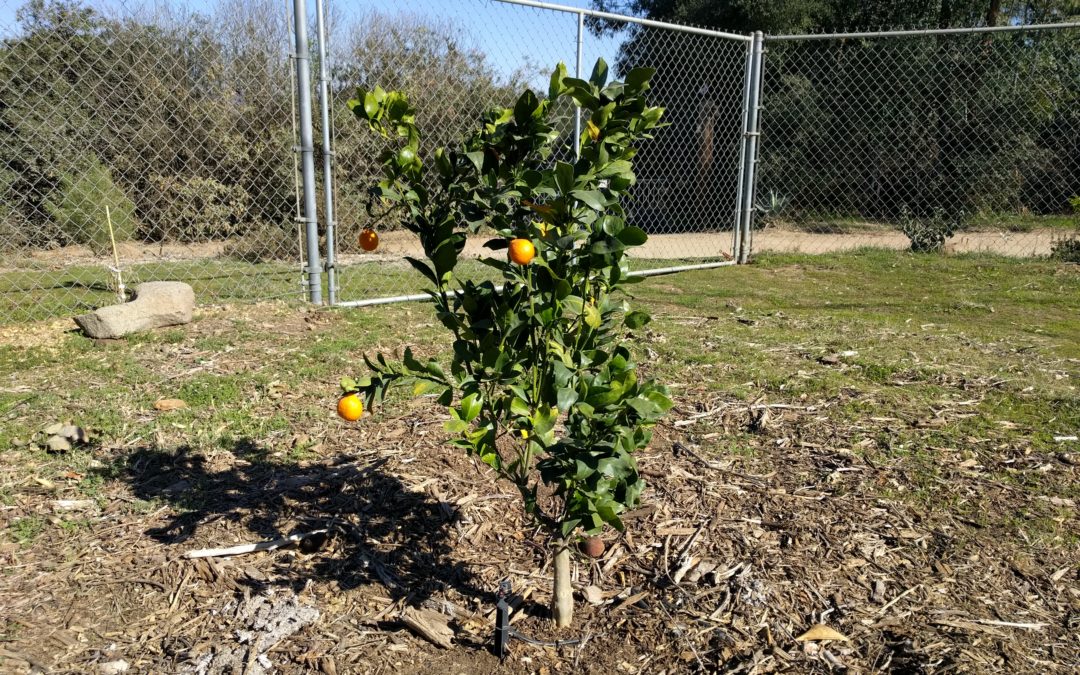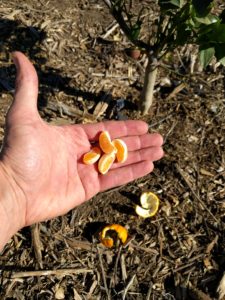My Pixie mandarin tree is carrying its first fruit, which look pitiful. They’re small, warped. If I didn’t know better, I’d say Pixie mandarins are no good, and I’d replace it with a different mandarin.
Luckily, I’ve had fruit off of mature Pixie trees. They’re bigger, beautiful, peel easily, seedless, and flavorful: everything you could want in a mandarin. Also fortunately, I’ve had the experience of eating the first fruit from other citrus trees I planted and know that they’re sometimes inferior to the fruit the tree later produces. I won’t judge this Pixie based on these initial offerings.
I remember my Cara Cara orange tree’s first fruits. They were also small, plus hard to peel and never very sweet. Later, they were just like the ones I’d had from mature trees. More often than with other types of trees, citrus seem to have these substandard first crops. I’ve been searching for an explanation, but have been unable to find one. Is it that the small-sized tree just can’t muster the power to build a full-sized and full-flavored fruit yet? That’s my only guess.
In the California Master Gardener Handbook’s chapter on citrus I read: “Many citrus types yield bland fruit for the first few years of production, but quality improves as trees mature.” I’ve heard other citrus growers say the same thing. So at least I know I’m not alone in this experience.
Note that the Handbook said many citrus, not all. That’s also been my experience. For example, my Kishu and Gold Nugget mandarins sized up well and tasted great from crop one. And they were small trees. So my guess about the cause is probably wrong.
Anyway, this phenomenon of subpar first fruits is not exclusive to citrus. I planted a SpiceZee nectaplum last year and it set one fruit, one scarred little fruit. The thing was mealy and mushy at the time I ate it. But I have many friends who tell me their SpiceZee nectaplum is the star of their orchard, so I eagerly await its second crop, its first real crop.
One reason my SpiceZee fruit didn’t taste good is probably that I picked it late. In other words, it was my fault. Almost always, a tree’s first crop is small in quantity, which gives you a thin margin for error in terms of picking the fruit at the optimal time. Also, since it’s likely to be your first experience growing that particular variety (I’d never grown a nectaplum in my yard before), you just can’t know exactly when to pick the fruit in your yard’s microclimate. No harvest chart you might refer to, such as Dave Wilson’s, can be that accurate — not to mention the fact that the weather is different every year.
I expect my nectaplum to grow up similar to the way my Snow Queen nectarine has. I love my Snow Queen nectarine tree today, but in its first summer with a crop I thought I might cut it down. The few fruits were mostly split open, and many were too soft in texture for my liking as soon as they started tasting as sweet as I wanted. Nowadays, however, the fruit quality has improved in every way.
And with crops of a hundred nectarines, I can start testing fruit very early because I have so many to spare. Many peaches and nectarines and plums and apricots have short harvest windows, making it very easy to miss picking them at exactly your preferred ripeness. It is very helpful to feel free to “waste” fruit by tasting one here and there before you’re sure they’re ripe, as you can with a mature tree that is loaded.
The point I hope to make here is that if you planted a new fruit tree in the last year or two and you’re looking at your first crop this year, don’t jump to conclusions on its size, taste, and overall quality. Like my Pixies, they might be small and funny at first.
Further, don’t think that changing your care of the young tree will improve its fruit. More fertilizer or water or pruning is almost certainly not going to be of benefit. What will help? A little patience.
You might also like to read:





Your posts are always such perfect timing. I sometimes wonder if you’re hiding in the hills watching me screw things up.
Would this same advice apply in the case of a seedling avocado tree, where you don’t really know what the final outcome of the pollination will be? I inherited a Hass seedling on my property, and it finally produced its first crop this year. Very disappointing fruit. But I’ve waited this long, I figure maybe give it a few years of production before I judge whether to keep it?
I think he must be watching me here in Lakeside too. I’ll be sitting here thinking “should I plant garlic” and two days later, I get an email telling me to plant garlic.
Hi Shawn,
That’s hilarious! In fact, I do live up in the hills, but I’m only watching myself screw things up. Guess we’re doing some of the same garden experiments.
I’d say avocados also shouldn’t be judged by their first crop. I’d give your seedling avocado a few years to show what it’s got. I suppose that if the fruit was absolutely terrible in its first crop though, then it’s unlikely to turn out to be amazing.
My mom has a seedling avocado in her backyard and it’s first crop was tasty but stringy. In subsequent years it has changed a little bit but still has the same general taste and sometimes has some fiber near the stem end.
I know that in the avocado breeding program run by UC Riverside they don’t make any final conclusions on seedling trees based on a first crop unless the fruit is clearly nothing like what they want. They give the seedling trees a number of years of evaluation. Before they decide on whether to patent a variety and offer it commercially, they’ve usually been evaluating its crops for around a decade.
Even the Hass itself was planted as a seed in 1926 and then not patented until 1935 after a handful of years of cropping.